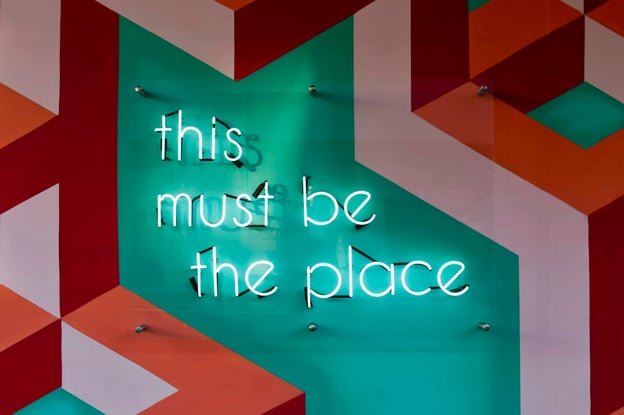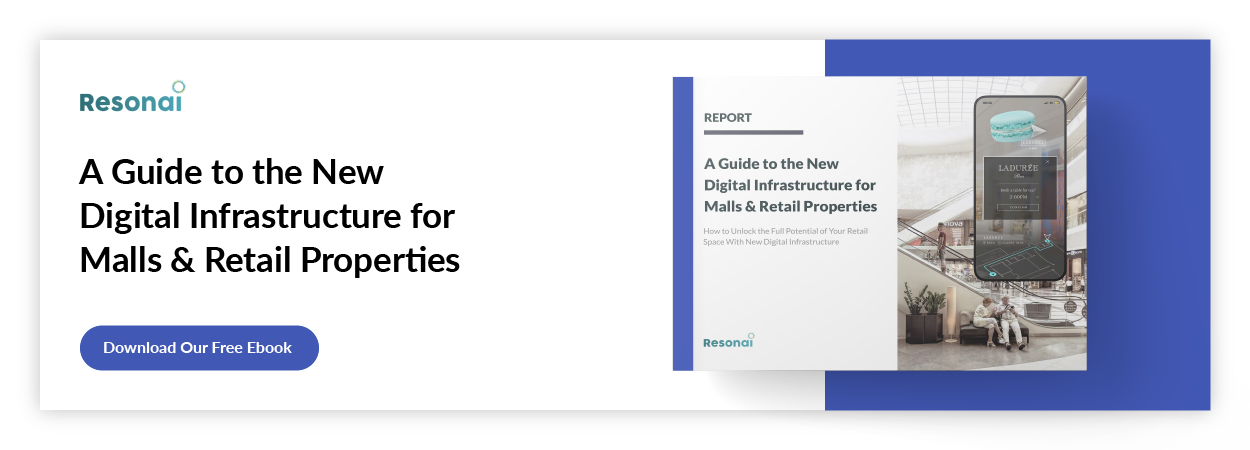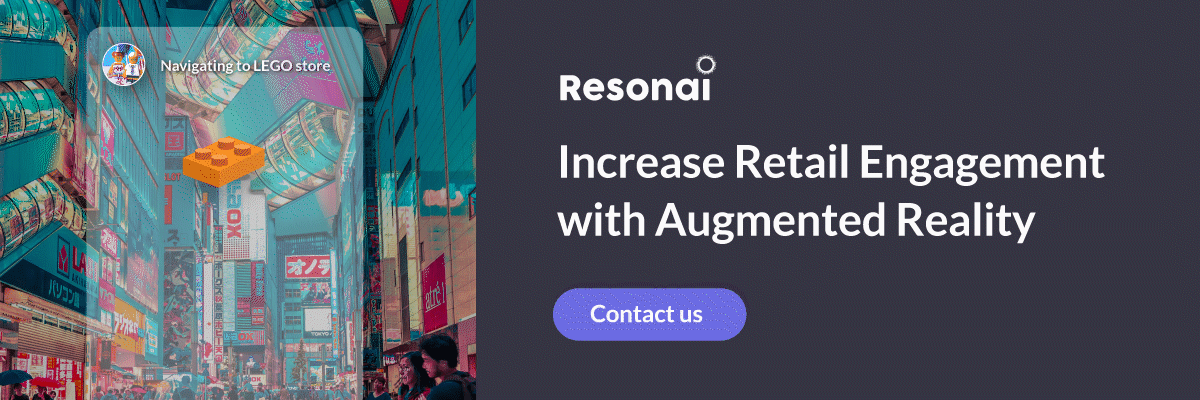3 Storefront Signs Turning Foot Traffic Into Sales
How retail brands are using everything from augmented reality to QR codes to connect with consumers

Retail signage tech has evolved rapidly in recent years. The rise of digital signage, mobile technology, and augmented reality (AR) has transformed what storefront signs can do. It’s changed traditional static displays into interactive experiences, allowing consumers to get far more from signs than just information on the latest sale.
This article outlines the benefits of retail storefront signs and explores three brands whose tech-forward approach to this classic marketing tactic is helping them turn foot traffic into revenue.
Jump to a section…
What are the benefits of storefront signs?
3 examples of storefront signs turning foot traffic into sales
How Lacoste used QR codes to gamify the brick-and-mortar experience
How La Taqueria used customer reviews in their digital signage
How Timberland used AR to shortcut the in-store shopping process
How to become a shop front signage innovator
Looking to upgrade your storefront signs with AR? Download our free Ebook to learn what this new technology could do for your retail brand.
What are the benefits of storefront signs?
Consumer research strongly suggests that shop front signage is one of the most powerful retail marketing tactics. Recent research by Yodeck found that 75% of retail business owners report street-facing signage boosts in-store foot traffic, and 90% believe digital signage increases retail brand awareness. A 2022 study by Solomon Partners and OAAA also supports the effectiveness of this tactic, revealing that outdoor signage trumps online, television, radio, and print ads on a cost-per-thousand impressions (CPM) basis. In other words, retail storefront signs create massive value for the brands that use them strategically.
3 examples of storefront signs turning foot traffic into sales
How Lacoste used QR codes to gamify the brick-and-mortar experience
Fashion brand Lacoste was one of the first retailers to use QR codes to inject some fun into the in-store shopping experience.
One of digital marketing’s biggest advantages over traditional marketing is interactivity. For example, brands like Frito Lay have used playable mobile ad campaigns for years to connect with consumers and generate interest. These experiences turn advertising’s one-way paradigm on its head, giving consumers the ability to actually engage in the experience instead of just passively receiving promotional information.
Seeing the potential of emerging tech, Lacoste used QR codes, retail signage, and a simple mobile game to bring that same level of interactivity to brick-and-mortar shopping. QR code graphics displayed on Lacoste storefront windows allowed visitors to play in the Lacoste Championship: a simple mobile game modeled after the arcade classic, Pong. After playing, the shopper earned 15% off in-store purchases and could enter to win a prize in a drawing. The QR codes also served as a gateway for product catalogs and other information.
Takeaway: QR codes can do more than just menus: They can bridge the gap between your physical and digital properties, leveraging mobile marketing tactics to enhance in-store shopping. Got a favorite digital marketing campaign? Clever use of QR codes could bring a similar experience to your brick-and-mortar customers.
How La Taqueria used customer reviews in their digital signage
San Francisco restaurant La Taqueria used digital signage to showcase its stellar customer reviews and boost customer interest.
American shoppers rate online reviews as the second most important part of the shopping experience, and 49% of consumers consider online reviews to be as trustworthy as personal recommendations. Despite this fact, many retail businesses don’t effectively leverage their online reputation to connect with in-store consumers. Their storefront signs often advertise promotions and new products, but rarely display the numerous positive reviews their brand generates online.
La Taqueria decided to buck this trend, using their restaurant’s digital signage to proudly showcase customer reviews alongside their menu. Drawing from the thousands of reviews on their Yelp profile, La Taqueria gave curious visitors ample reason to try out their burritos, tacos, and quesadillas. If the smell of their cooking wasn’t enough, this clever tactic was just the nudge some consumers needed to sit down for a meal.
Takeaway: Whether they are from Facebook, TripAdvisor, Yelp, or beyond, your customer reviews are a powerful resource you should use wherever you can. While La Taqueria used customer reviews on their menu screens, retail brands can easily take this tactic to the storefront to maximize the impact of organic endorsements.
How Timberland used AR to shortcut the in-store shopping process
Footwear and clothing retailer Timberland used the power of AR to overcome barriers and drive more traffic into its stores.
For most consumers, buying shoes or apparel in person is a time-consuming process. They have to scour the store for attractive styles, find the right size, check into a dressing room, try on different pieces, and more — all before they ever approach the checkout line.
To shortcut this process, Timberland used a combination of digital signage and AR tech to help potential customers immediately see themselves in their products. When consumers approached the retailer’s storefront, they were met with their image displayed on a flat-screen monitor TV behind the glass. Using onscreen guides, the system would capture their likeness as an avatar that they could then dress with Timberland’s latest styles. Consumers could try on dozens of outfits in a matter of seconds, allowing them to quickly find pieces they liked and could immediately purchase in-store.
Takeaway: Physical signage will always be a key part of retail, but it has its limitations. AR signage, on the other hand, opens up new worlds of possibility for retailers — empowering creative brands to engage with consumers in novel and powerful ways. If you’re looking to stand out, consider how AR could help you provide consumers with a unique storefront experience.
Want to learn more about how your approach to retail signage can improve foot traffic, increase revenue, and more? Be sure to check out Retail Store Signs: The Ultimate Guide.
How to become a shop front signage innovator
Storefront signs provide an excellent opportunity for retailers to create rich brand experiences and build consumer relationships. But brands can only realize that potential if they take a creative approach. Nearly every brick-and-mortar business on Earth uses signage to connect with consumers. How can your brand be different?
If you're looking for a new way of approaching retail signage, download Resonai’s latest ebook: A Guide to the New Digital Infrastructure for Malls & Retail Properties. It outlines how forward-thinking retail brands can use AR signage to unlock new advertising revenue streams, deliver compelling experiences, and more.
Subscribe to Our Newsletter!
Read More
The 3 Biggest Benefits of Outdoor Retail Signage in 2022
Businesses have used signs to help direct customers to (and through) their doors for hundreds of...
The 5 Biggest Benefits of Indoor Retail Signage
Brand building and advertising is more complex than ever in the digital age as key demographics...
7 Retail Signage Design Best Practices You Need to Know
Crafting the perfect retail signage design for your business can make a huge difference. While ...

